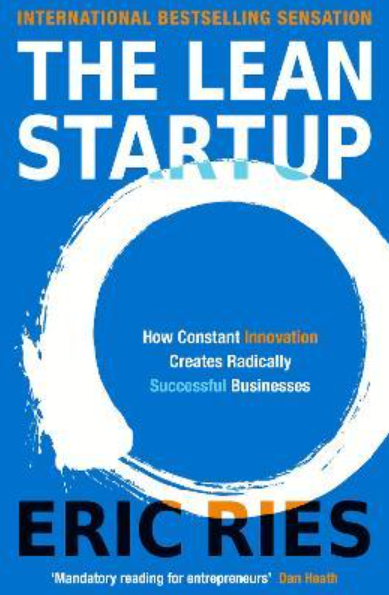Eric Ries’ may not be a name that everyone recognizes, but his hit bestseller, The Lean Startup is a book many have heard of. With over a million copies sold, and translated into thirty different languages, the Lean Startup is about adopting an entrepreneurial mindset, which makes us successful in not only the starting and running of our business but how we interact with all of our business relationships in any setting.
In this blog post, we share with you our review and summary of the Lean Startup and share our favorite ideas that you can get from reading this book.
The Lean Startup Summary
From his years at IMVU, the largest avatar-focused social media site, Ries went on to join a venture capital firm where he advised startups directly. Using his knowledge gained from large exposure to dozens and dozens of companies, he adopted the lean movement and started compiling all of his knowledge into a book. The result was The Lean Startup, an entire guide to being a successful entrepreneur, and the only one you would need.

This 2011 phenomenon explains that entrepreneurship is not just about business owners but also in the mind of employees, managers and freelancers. Encouraging an entrepreneurial mindset benefits everyone, and lets colleagues and superiors take responsibility for themselves and their team.
Best ideas and main concepts of the Lean Startup
The book is broken down into three different sections, Vision, Steer and Accelerate. The lion share of the book takes place in the middle, “Steer” so it seemed only appropriate to take the three best points:
- Validate your business model before you commit to it, which ensures success from the start
- Test, test and test different iterations of your product
- Busy work, and measuring the wrong metrics of success can be seductive, but ultimately meaningless
Validate your idea, and you will have a winning business model
There is a famous saying that entrepreneurship is half art, half science. This summarizes The Lean Startup to a “T”, with Ries calling it “Semi-Scientific”. The notion of the lean method is never going for “perfect” but rather, aim for “good” enough and keep running with it. The “Science” part of this method starts with following the method we learned as children, form a hypothesis, test it, record results and keep the winners.
In order to find a winner, which is a sustainable business model that can last long term (at least 5-10 years) you have to go through the process. Start with your idea(s) and passion(s) that drove you to start this project or business in the first place. For example, Uber thought they can outsource their drivers and create a freelance/contract business model, opposed to the badge ownership system of the dominant taxi industry. They pivoted from their original idea of a private limousine passenger service.
from here, the science ends, and the art begins. Instead of needing to conduct in-depth academic analysis and peer reviews before publishing an MVP (minimum viable product) you quickly get your idea out there and see if it sticks. With Uber, this involved contracting friends, and sitting at airports and pitching to already employed taxi drivers to their new “ride-share” model. In the case of Uber, it clearly became a success, but they had to pivot from their original idea and take on a dominant taxi behemoth, which they still contend with to this day in certain areas and countries.
Test a Few Good Iterations of Your Product or Service
Originally called “split-testing”, now a common marketing term is “A/B” testing, which involves testing exactly 2 versions of the service or product that you are trying to sell. It is important to remember when A/B testing to get others to pay for your good as early as possible, as testing between ideas, comments and notions does not properly give you feedback. In order for you to know that this will be a success, you have to see what value your customers or clients have for that product, and whether that perceived value outweighs the price or not.
Through split testing, not only are you trying versions of your product, but you are also giving your potential customer or client a choice. Instead of choosing your product or not, they can choose product “A” and product “B”.
With the advent of the internet, and more specifically web 2.0, we can split test many different aspects very quickly. For example, creating prototypes for a banner for a marketing campaign would take illustrators a long time, but now, they can design and deploy online from anywhere in the world and with extreme speed. Failing fast is a huge advantage of the lean movement, as you find out what doesn’t work quickly and you can pivot from there until it works.
Find the Key Metrics That Don’t Flatter You
Probably the most important takeaway from this book, and the lean method in general, is you first have to define what success means. so called “vanity” metrics are extremely dangerous to you and your business and usually will destroy an idea before it gains any traction. Always select good key performance indicators (KPI) and stick to them.
When first starting out, the metrics are very simple – how many clients do you have, and are they paying you? After this, when you actively start to manage your company and deliver instead of sales taking up 100% of the day, you can start to see what’s meaningful. Are you being recommended? Are users/clients/customers coming back? What % of your sales turn into upsells for more premium services? Are clients generally happy with your product/service?
It is dangerous to follow metrics such as how many phones are being dialed, how many followers you’ve gained on social media or the % increase/decrease of likes on your posts from one week to another. These are Vanity metrics and may make you feel good seeing the numbers go up, they don’t actively contribute to getting your business off the ground or increasing the top line.
The Lean Startup Review & Should You Read This Book?
As it is becoming more common with successful books in the self-help and general financial genre, The Lean Startup began as a blog, and as such, offers great points that have already helped others and continues to have resources long after the book has been read. In this way, Ries took his own medicine and created a self-fulfilling prophecy with his book. His idea was already tested with his successful blog, and the posts were re-written into this great book.
Everyone should pick up The Lean Startup if you have started or are about to start your professional journey. Whether you are a veteran business owner, a new entrepreneur, an entry-level clerk at work or a manager looking to grow their career, The Lean Startup is sure to add a little “Semi-Scientific” spice in your life. Happy reading!

